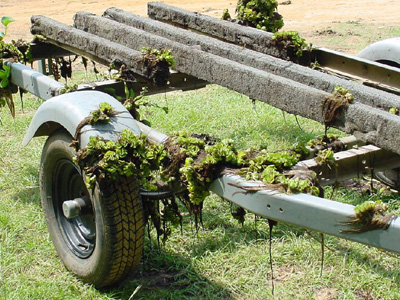Stop Invasive Aquatic Hitchhikers!
Fish, shellfish, and aquatic plants that are not native to Texas may multiply rapidly, compete with native animals and plants for food and space, and cause harm to our ecosystems, get in the way of recreation, and cause economic damage. Introduced species often lack natural enemies or competitors in their new environment, and may multiply and spread at an alarming rate, intefering with boat traffic, affecting water quality, and causing a range of other problems. In order to manage and conserve our natural resources and protect outdoor recreation opportunities, Texas Parks and Wildlife Department enforces laws to protect our state waters against the introduction of exotic aquatic species. For more information, visit TexasInvasives.org. Invasive species that have been introduced into water bodies often travel from one water body to another by "hitching a ride" on a watercraft. Read on to find out how to stop them.
Water Draining Rule
Invasive zebra mussels have infested several Texas lakes. The microscopic larvae of this species can't be seen with the naked eye, but they can travel from one watershed to another in a bilge or livewell. To curb the spread of zebra mussels, boaters and anglers in public fresh waters are required to drain all water from boats and onboard receptacles before leaving or approaching a water body.

Clean Watercraft and Trailers
Boaters in Texas are also required by law to remove any visible plants and animals from all watercraft and trailers before leaving the vicinity of a lake, river, or bay. By following the Clean, Drain and Dry procedure described below, you can minimize the chances of accidental transfer.
For information on transporting a boat that has been stored on a zebra mussel-infested water body or has zebra mussels attached, please contact TPWD at (512) 389-4848 a few weeks before you plan to move the boat. You may need to have your boat professionally cleaned with high-pressure scalding hot water (>140°F) before transporting to any other body of water.

Follow These Simple Steps
- Clean
- Remove all plants, animals, and mud and thoroughly wash the boat and trailer. A quick trip to the car wash to use high-pressure spray nozzles can help clean crevices and hidden areas. (Remember that boats stored on infested waters may need to be professionally decontaminated.)
- Drain
- Pull the plug! Drain all water before leaving the area, including livewells, bilges, ballast, and engine cooling water.
- Dry
- Allow your boat to dry completely before launching in other waters—ideally for a week or more.
Clean Water Certification Program
The Clean Water Certification Program requires owners of boats with marine sanitation devices (MSDs) and owners of pump-out stations to obtain a decal, self-certifying that the MSD or pump-out station is operating properly to prevent the discharge of sewage into Texas waterways. The program is required under Texas law and is intended to protect and improve the quality of water in Texas. It is administered by the Texas Commission on Environmental Quality (TCEQ).